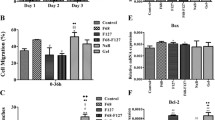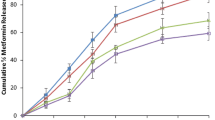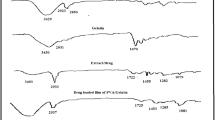Abstract
Burns alter the normal skin barrier and affect various host defense processes that help prevent infections. An ineffective repair process can lead to serious damage, such as the onset of an infection or skin loss, which can then harm the surrounding tissues and ultimately the entire organism. This study aims to prepare in situ gels containing metformin hydrochloride, a compound known for its wound healing properties. To achieve this, in situ gels were prepared using three different gelling agents (Poloxamer 407®, Carbopol 934®, and sodium carboxymethyl cellulose (Na-CMC)) and three different concentrations of metformin hydrochloride (4 mg/g, 6 mg/g, and 8 mg/g), which were optimized through experimental design. Metformin concentration and gelling agent type were independent variables, and the loaded amount and the percentage of metformin released after 150 min were chosen as dependent variables in the optimization process. After determining the optimum values of the dependent variables according to the ANOVA analysis results, in vivo studies were conducted with optimized hydrogel formulations. Two groups, each consisting of seven Wistar rats with a burn model, were treated with metformin-poloxamer 407® gels at doses of 4 mg/g and 8 mg/g for 29 days. The results were then compared to untreated and placebo gel groups. Rats treated with in situ Poloxamer 407® hydrogels containing metformin hydrochloride showed a significant reduction in the size of the burned area after 29 days of treatment. However, for a comprehensive understanding of the wound healing mechanism, further studies such as immuno-histochemical and cell culture studies are needed.
Graphical Abstract








Similar content being viewed by others
Data Availability
No ready-made data (such as pictures, tables) was used directly in the study.
Change history
12 December 2023
A Correction to this paper has been published: https://doi.org/10.1208/s12249-023-02715-4
References
Yang G, Seok JK, Kang HC, Cho YY, Lee HS, Lee JY. Skin barrier abnormalities and immune dysfunction in atopic dermatitis. Int J Molecular sciences. 2020;21:2867.
Zhang J, Zhu Y, Zhang Y, Lin W, Ke J, Liu J. A balanced charged hydrogel with anti-biofouling and antioxidant properties for treatment of irradiation-induced skin injury. Materials Sci Engin: C. 2021;131:112538.
Noor A, Afzal A, Masood R, Khaliq Z, Ahmad S, Ahmad F, Irfan M. Dressings for burn wound: a review. J Mater Sci. 2022;57(12):6536–72.
Tawfeek HM, Abou-Taleb DA, Badary DM, Ibrahim M, Abdellatif AA. Pharmaceutical, clinical, and immunohistochemical studies of metformin hydrochloride topical hydrogel for wound healing application. Archives of Derma Res. 2020;312:113–21.
Wilkinson HN, Hardman MJ. Wound healing: cellular mechanisms and pathological outcomes. Open Biology. 2020;10(9):200223.
D. Li, N. Wu. Mechanism and application of exosomes in the wound healing process in diabetes mellitus. Diabetes Research and Clinical Practice. 2022: 109882.
L. Roshangar, R. Kheirjou, R. Ranjkesh, Skin burns: review of molecular mechanisms and therapeutic approaches. Wounds: a compendium of clinical research and practice. 2019; 31: 308-315
Stoica AE, Chircov C, Grumezescu AM. Hydrogel dressings for the treatment of burn wounds: an up-to-date overview. Materials. 2020;13:2853.
Thapa RK, Diep DB, Tønnesen HH. Topical antimicrobial peptide formulations for wound healing: current developments and future prospects. Acta Biomater. 2020;103:52–67.
Jones M, Ionescu CM, Walker D, Wagle SR, Kovacevic B, Chester J, Al-Salami H. Biguanide pharmaceutical formulations and the applications of bile acid-based nano delivery in chronic medical conditions. Int J Molecul Sci. 2022;23(2):836.
Miricescu D, Badoiu SC II, Stanescu-Spinu AR, Totan C, Stefani M. Greabu. Growth factors, reactive oxygen species, and metformin—promoters of the wound healing process in burns? Int J Molecular Sc. 2021;22:9512.
Qing L, Fu J, Wu P, Zhou Z, Yu F, Tang J. Metformin induces the M2 macrophage polarization to accelerate the wound healing via regulating AMPK/mTOR/NLRP3 inflammasome singling pathway. Ame J Trans Res. 2019;11(2):655.
Madhu LN, Kodali M, Shetty AK. Promise of metformin for preventing age-related cognitive dysfunction. Neural Regene Res. 2022;17(3):503.
Veitz-Keenan A, Calle TDS, Bergamini M. Limited evidence suggests metformin might be beneficial to reduce head and neck cancer risk and ıncrease overall survival, while any benefit with antiinflammatory drugs ıs ınconsistent. J Evid Based Dental Prac. 2019;19(3):298–300.
J. Kusturica, A. Kulo, M. Rakanović-Todić, L. Burnazović-Ristić, S. Maleškić. Potential protective effects of metformin on ocular complications in patients with type 2 diabetes. In Metformin. 2020; IntechOpen.
Zheng M, Zhu Y, Wei K, Pu H, Peng R, Xiao J, Sun X. Metformin attenuates the ınflammatory response via the regulation of synovial M1 macrophage in osteoarthritis. Int J Mole Sci. 2023;24(6):5355.
Yari S, Khoei HH, Saber M, Esfandiari F, Moini A, Shahhoseini M. Metformin attenuates expression of angiogenic and inflammatory genes in human endometriotic stromal cells. Exp Cell Res. 2021;404(2):112659.
Liu Z, Tang W, Liu J, Han Y, Yan Q, Dong Y, Cao H. A novel sprayable thermosensitive hydrogel coupled with zinc modified metformin promotes the healing of skin wound. Bioactive Mater. 2023;20:610–26.
Wang P, Huang S, Hu Z, Yang W, Lan Y, Zhu J, Tang B. In situ formed anti-inflammatory hydrogel loading plasmid DNA encoding VEGF for burn wound healing. Acta Biomaterialia. 2019;100:191–201.
Manikkath J, Subramony JA. Toward closed-loop drug delivery: ıntegrating wearable technologies with transdermal drug delivery systems. Adv Drug Deliv Rev. 2021;179:113997.
Ng LC, Gupta M. Transdermal drug delivery systems in diabetes management: a review. Asian J Pharma Sci. 2020;15:13–25.
Ahmed J, Gultekinoglu M, Edirisinghe M. Bacterial cellulose micro-nano fibres for wound healing applications. Biotechnol Adv. 2020;41:107549.
Zagórska-Dziok M, Sobczak M. Hydrogel-based active substance release systems for cosmetology and dermatology application: a review. Pharmaceutics. 2020;12(5):396.
N.A. Peppas, A.G Mikos, Preparation methods and structure of hydrogels. In Hydrogels in medicine and pharmacy. 2019; (pp. 1-26). CRC press.
Stern D, Cui H. Crafting polymeric and peptidic hydrogels for improved wound healing. Adv Healthcare Mater. 2019;8:1900104.
Banjara GP, Porte P. Effect of hydrogel applications and foliar nutrition sprays on yield attributes, seed and stover yield of chick pea crop. Pharma Innov J. 2022;11(1):159–61.
Kalam MA, Alkholief M, Badran M, Alshememry A, Alshamsan A. Co-encapsulation of metformin hydrochloride and reserpine into flexible liposomes: characterization and comparison of in vitro release profile. J Drug Deliv Sci Technol. 2020;57:101670.
Csenkey A, Hargitai E, Pakai E, Kajtar B, Vida L, Lorincz A, Garami A. Effectiveness of four topical treatment methods in a rat model of superficial partial-thickness burn injury: the advantages of combining zinc-hyaluronan gel with silver foam dressing. Injury. 2022;53:3912–9.
J.L. Soriano-Ruiz, A.C. Calpena-Campmany, M. Silva-Abreu, L. Halbout-Bellowa, N. Bozal-de Febrer, M.J. Rodriguez-Lagunas, B. Clares, Design and evaluation of a multifunctional thermosensitive poloxamer-chitosan-hyaluronic acid gel for the treatment of skin burns. International journal of biological macromolecules. 2020; 142: 412-422.
Mohammed WH, Ali WK, Al-Awady MJ. Evaluation of in vitro drug release kinetics and antibacterial activity of vancomycin HCl-loaded nanogel for topical application. J Pharma Sci Res. 2018;10:2747–56.
Chao Y, Wei T, Li Q, Liu B, Hao Y, Chen M, Liu Z. Metformin-containing hydrogel scaffold to augment CAR-T therapy against post-surgical solid tumors. Biomaterials. 2023;295:122052.
Huang Y, Mu L, Zhao X, Han Y, Guo B. Bacterial growth-induced tobramycin smart release self-healing hydrogel for Pseudomonas aeruginosa-infected burn wound healing. ACS nano. 2022;16:13022–36.
Abdallah MH, Abdelnabi DM, Elghamry HA. Response surface methodology for optimization of buspirone hydrochloride-loaded ın situ gel for pediatric anxiety. Gels. 2022;8:395.
Zheng B, Shen C, Sun J, Guo W, Jin Y, Niu Y. Developing a simple burn model in rats of different ages. J Burn Care Res. 2019;40:639–47.
Xiao T, Chen Y, Song C, Xu S, Lin S, Li M, Gu H. Possible treatment for UVB-induced skin injury: anti-inflammatory and cytoprotective role of metformin in UVB-irradiated keratinocytes. J Dermatol Sci. 2021;102:25–35.
Ostróżka-Cieślik A, Maciążek-Jurczyk M, Pożycka J, Dolińska B. Pre-formulation studies: physicochemical characteristics and ın vitro release kinetics of ınsulin from selected hydrogels. Pharmaceutics. 2021;13:1215.
Nawaz A, Ullah S, Alnuwaiser MA, Rehman FU, Selim S, Al Jaouni SK, Farid A. Formulation and evaluation of chitosan-gelatin thermosensitive hydrogels containing 5fu-alginate nanoparticles for skin delivery. Gels. 2022;8(9):537.
H. Li, B. Li, D. Lv, W. Li, Y. Lu, G. Luo. Biomaterials releasing drug responsively to promote wound healing via regulation of pathological microenvironment. Advanced Drug Delivery Reviews. 2023; 114778.
Qushawy M. Effect of the surfactant and liquid lipid type in the physico-chemical characteristics of beeswax-based nanostructured lipid carrier (NLC) of metformin. Pharma Nanotechnol. 2021;9(3):200–9.
Ostróżka-Cieślik A, Maciążek-Jurczyk M, Pożycka J, Dolińska B. Pre-formulation studies: physicochemical characteristics and ın vitro release kinetics of ınsulin from selected hydrogels. Pharmaceutics. 2021;13:1215.
Nawaz A, Ullah S, Alnuwaiser MA, Rehman FU, Selim S, Al Jaouni SK, Farid A. Formulation and evaluation of chitosan-gelatin thermosensitive hydrogels containing 5fu-alginate nanoparticles for skin delivery. Gels. 2022;8(9):537.
H. Li, B. Li, D. Lv, W. Li, Y. Lu, G. Luo. Biomaterials releasing drug responsively to promote wound healing via regulation of pathological microenvironment. Advanced Drug Delivery Reviews. 2023; 114778.
Qushawy M. Effect of the surfactant and liquid lipid type in the physico-chemical characteristics of beeswax-based nanostructured lipid carrier (NLC) of metformin. Pharma Nanotechnol. 2021;9(3):200–9.
Author information
Authors and Affiliations
Contributions
EDO: data collection, writing, visualization, and data curation.
RC: data collection, editing, and assessment.
TC: data curation, assessment, conceptualization, reviewing, and assessment.
HRO: data curation, editing, and assessment.
KB: data collection, editing, and assessment.
Corresponding author
Ethics declarations
Competing Interests
The authors declare no competing interests.
Additional information
Communicated by Nisarg Modi, Yousuf Mohammed, and Lakshmi Raghavan.
Publisher's Note
Springer Nature remains neutral with regard to jurisdictional claims in published maps and institutional affiliations.
The original article has been corrected to upate affiliations for authors Emine Dilek Ozyilmaz, Rojhat Celikkaya, Tansel Comoglu, and Hulda Rifat Ozakpinar.
Rights and permissions
Springer Nature or its licensor (e.g. a society or other partner) holds exclusive rights to this article under a publishing agreement with the author(s) or other rightsholder(s); author self-archiving of the accepted manuscript version of this article is solely governed by the terms of such publishing agreement and applicable law.
About this article
Cite this article
Ozyilmaz, E.D., Celikkaya, R., Comoglu, T. et al. In Vitro and In Vivo Evaluation of Metformin Hydrochloride Hydrogels Developed with Experimental Design in the Treatment of Burns. AAPS PharmSciTech 24, 248 (2023). https://doi.org/10.1208/s12249-023-02704-7
Received:
Accepted:
Published:
DOI: https://doi.org/10.1208/s12249-023-02704-7




